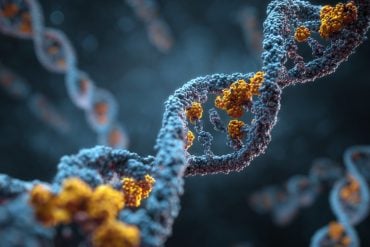Summary: Efficient connection pathways across the entire brain provide a neural network that supports general cognitive function and ability. Higher fractional anisotropy is associated with higher IQ.
Source: National University of Ireland Galway
An international collaborative study led by researchers from the NUI Galway provides findings on the neural basis of intelligence, otherwise known as general cognitive ability (IQ).
This new research uses an imaging technique called diffusion tensor imaging (DTI) to provide an insight into how small variations in this wiring system are associated with differences in IQ in both the general population and how disorders such as schizophrenia manifest.
Over 40 scientists from around the world were involved in analysing brain MRI scans and measures of cognitive function of 1,717 participants, with both healthy functions and patients with schizophrenia. This resulted in a new method to harmonise data collection and analysis as part of the Enhancing Neuroimaging Genetics through Meta-Analysis project (ENIGMA), Schizophrenia Working Group. The study, published in The American Journal of Psychiatry, was led by Dr Laurena Holleran, Lecturer in Clinical Neuroscience and Professor Gary Donohoe, Established Professor at NUI Galway’s School of Psychology and Centre for Neuroimaging Cognition and Genomics.
Commenting on the findings, lead author Dr Laurena Holleran, stated that: “To date, this is the largest meta-analysis study of brain structure and cognitive function in schizophrenia. Understanding the neural basis of cognitive function is essential so that effective therapies that address difficulties associated with disorders like schizophrenia, which aren’t targeted by current treatments. This is important because cognitive deficits associated with the disorder strongly predict social and functional outcomes, such as employment or social relationships.

“Previous literature suggested that general intelligence relies on specific grey matter areas of the brain, including temporal, parietal and frontal regions. However, the results from this study indicate that efficient connection pathways across the entire brain provide a neural network that supports general cognitive function.”
According to the study’s senior author Professor Gary Donohoe: “These results advance our knowledge in a number of ways. Firstly, we have demonstrated that the relationship between brain structure and intelligence not only involves grey matter, but also white matter – the brain’s wiring system. Secondly, it’s not just one part of this wiring system that is important for intelligence, but rather the wiring system as a whole. And finally, the relationship between intelligence and the brain’s wiring system is basically the same in patients with schizophrenia and healthy people, in that the lack of pattern explains their cognitive abilities. This suggests that cognitive function in patients is the same as the general population, at least as far as white matter is concerned.”
Source:
National University of Ireland Galway
Media Contacts:
Sheila Gorham – National University of Ireland Galway
Image Source:
The image is in the public domain.
Original Research: Closed access
“The Relationship Between White Matter Microstructure and General Cognitive Ability in Patients With Schizophrenia and Healthy Participants in the ENIGMA Consortium”. Laurena Holleran et al.
American Journal of Psychiatry doi:10.1176/appi.ajp.2019.19030225.
Abstract
The Relationship Between White Matter Microstructure and General Cognitive Ability in Patients With Schizophrenia and Healthy Participants in the ENIGMA Consortium
Objective:
Schizophrenia has recently been associated with widespread white matter microstructural abnormalities, but the functional effects of these abnormalities remain unclear. Widespread heterogeneity of results from studies published to date preclude any definitive characterization of the relationship between white matter and cognitive performance in schizophrenia. Given the relevance of deficits in cognitive function to predicting social and functional outcomes in schizophrenia, the authors carried out a meta-analysis of available data through the ENIGMA Consortium, using a common analysis pipeline, to elucidate the relationship between white matter microstructure and a measure of general cognitive performance, IQ, in patients with schizophrenia and healthy participants.
Methods:
The meta-analysis included 760 patients with schizophrenia and 957 healthy participants from 11 participating ENIGMA Consortium sites. For each site, principal component analysis was used to calculate both a global fractional anisotropy component (gFA) and a fractional anisotropy component for six long association tracts (LA-gFA) previously associated with cognition.
Results:
Meta-analyses of regression results indicated that gFA accounted for a significant amount of variation in cognition in the full sample (effect size [Hedges’ g]=0.27, CI=0.17–0.36), with similar effects sizes observed for both the patient (effect size=0.20, CI=0.05–0.35) and healthy participant groups (effect size=0.32, CI=0.18–0.45). Comparable patterns of association were also observed between LA-gFA and cognition for the full sample (effect size=0.28, CI=0.18–0.37), the patient group (effect size=0.23, CI=0.09–0.38), and the healthy participant group (effect size=0.31, CI=0.18–0.44).
Conclusions:
This study provides robust evidence that cognitive ability is associated with global structural connectivity, with higher fractional anisotropy associated with higher IQ. This association was independent of diagnosis; while schizophrenia patients tended to have lower fractional anisotropy and lower IQ than healthy participants, the comparable size of effect in each group suggested a more general, rather than disease-specific, pattern of association.






